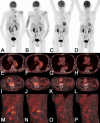PET/CT in therapy control of infective native aortic aneurysms
- PMID: 33658604
- PMCID: PMC7930044
- DOI: 10.1038/s41598-021-84658-z
PET/CT in therapy control of infective native aortic aneurysms
Abstract
Infective native aortic aneurysms (INAA) are aneurysms arising from infection of the aortic wall. Treatment is demanding with 5-year survival rates between 53 and 55%. The aim of our study was to evaluate the usefulness of 18F-fluorodeoxyglucose positron emission tomography/computed tomography (PET/CT) in the long-term monitoring of patients with proven INAA. Fifty-three PET/CT were performed in 15 patients with INAA in this single-center retrospective cohort study and retrospective analysis of prospectively collected Vascular Graft Cohort Study (VASGRA) data. Median metabolic activity (as measured by maximum standardized uptake value, SUVmax) of the aneurysms at the initial PET/CT was high (6.8 (IQR 5.7-21.8)), and lower at the last PET/CT prior to the end of antimicrobial therapy (3.9 (IQR 2.7-6.8); n = 11) as well as in the first PET/CT after the end of the treatment (3.9 (IQR 3.0-4.4);n = 6). Compared to the course of C-reactive protein alone, PET/CT provided different (> 20% difference in trend) or altering (opposed trend) information on the course of disease in at least 14 comparisons (56%) in 11 patients (73%). The one-year and five-year freedom from all-cause lethality was 92% (95% confidence interval 57%-99%). As compared to the course of C-reactive protein, PET/CT provides different and occasionally altering information in therapy control of INAA.
Conflict of interest statement
The authors declare no competing interests.
Figures



References
-
- Wilson WR, et al. Vascular graft infections, mycotic aneurysms, and endovascular infections: a scientific statement from the American Heart Association. Circulation. 2016;134:e412–e460. - PubMed
Publication types
MeSH terms
Substances
LinkOut - more resources
Full Text Sources
Other Literature Sources
Medical
Research Materials

